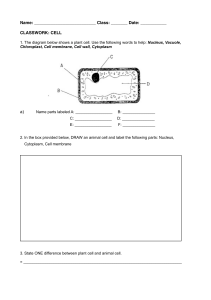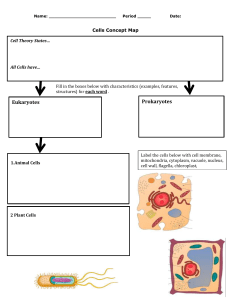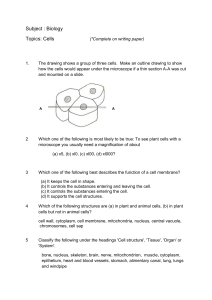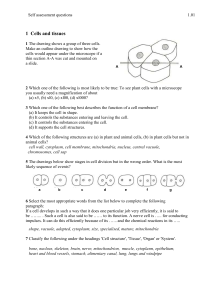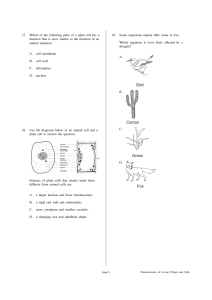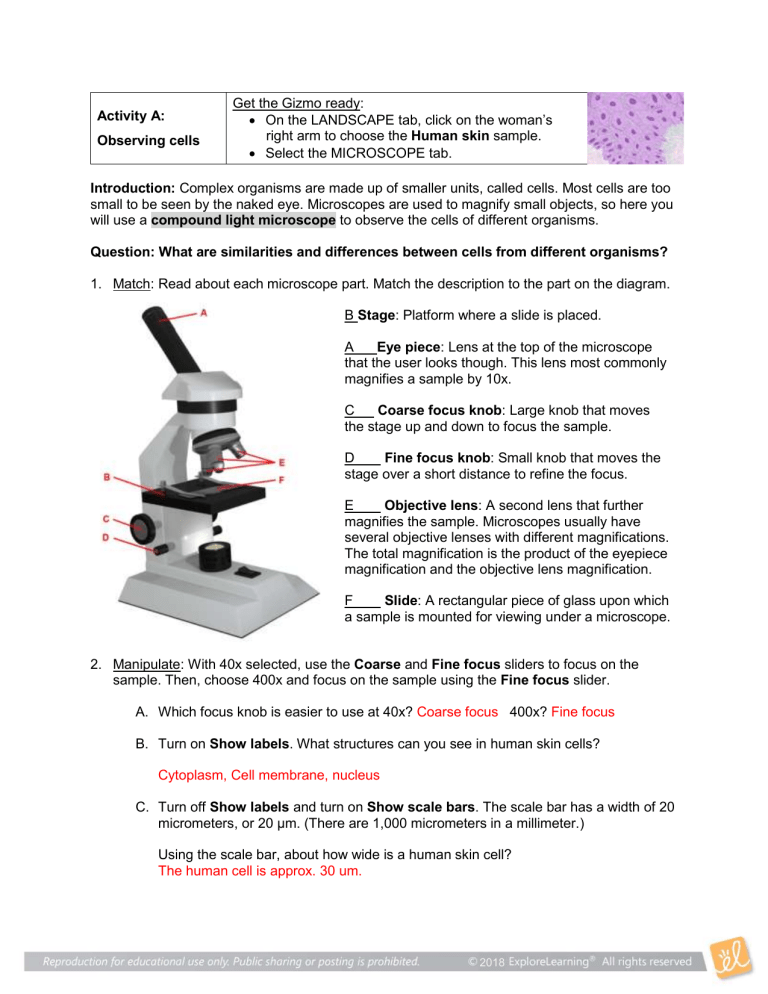
Activity A: Observing cells Get the Gizmo ready: On the LANDSCAPE tab, click on the woman’s right arm to choose the Human skin sample. Select the MICROSCOPE tab. Introduction: Complex organisms are made up of smaller units, called cells. Most cells are too small to be seen by the naked eye. Microscopes are used to magnify small objects, so here you will use a compound light microscope to observe the cells of different organisms. Question: What are similarities and differences between cells from different organisms? 1. Match: Read about each microscope part. Match the description to the part on the diagram. B Stage: Platform where a slide is placed. A Eye piece: Lens at the top of the microscope that the user looks though. This lens most commonly magnifies a sample by 10x. C Coarse focus knob: Large knob that moves the stage up and down to focus the sample. D Fine focus knob: Small knob that moves the stage over a short distance to refine the focus. E Objective lens: A second lens that further magnifies the sample. Microscopes usually have several objective lenses with different magnifications. The total magnification is the product of the eyepiece magnification and the objective lens magnification. F Slide: A rectangular piece of glass upon which a sample is mounted for viewing under a microscope. 2. Manipulate: With 40x selected, use the Coarse and Fine focus sliders to focus on the sample. Then, choose 400x and focus on the sample using the Fine focus slider. A. Which focus knob is easier to use at 40x? Coarse focus 400x? Fine focus B. Turn on Show labels. What structures can you see in human skin cells? Cytoplasm, Cell membrane, nucleus C. Turn off Show labels and turn on Show scale bars. The scale bar has a width of 20 micrometers, or 20 μm. (There are 1,000 micrometers in a millimeter.) Using the scale bar, about how wide is a human skin cell? The human cell is approx. 30 um. 2018 (Activity A continued on next page) Activity A (continued from previous page) 3. Observe: An organelle is a cell structure that performs a specific function. Observe the samples below under the highest magnification. Click the Show labels checkbox to label the organelles. List the organelles and approximate size of the cells in each sample. Sample Mouse skin Fly muscle Estimated size (μm) Organelles 17 μm Nucleus, Cell membrane, Cytoplasm 40 μm Nucleus, Cell membrane, Cytoplasm, Striation Maple leaf Nucleus, Cell membrane, Cytoplasm, Chloroplast, Cell Wall, Vacuole 16 μm Elodea Nucleus, Cell membrane, Cytoplasm, Chloroplast, Cell Wall, Vacuole 41 μm Fungus Nucleus, Cell membrane, Cytoplasm, Cell Wall, Vacuole, Septum 5 μm What do all of these samples have in common? Nucleus, Cell Membrane, Cytoplasm In eukaryotic cells, genetic material is contained inside a distinct, membrane-bound nucleus. Plant and animal cells are classified as eukaryotes. 4. Observe: Click on the cow and observe E. coli under the highest magnification. Notice the microscope magnification is larger for this organism, and notice the scale bar is smaller. A. What is the approximate size of E. coli? Approx. 0.5 μm B. What organelles are present in E. coli? Cell membrane, Cell wall, Cytoplasm, Flagellum, Pilus, and Nucleoid. C. What organelle is missing from E. coli? Nucleus E. coli is an example of a bacteria. Bacteria are classified as prokaryotic cells because their DNA is not contained in a membrane-bound nucleus. 5. Compare: Look at the Sand/silt sample under the microscope. A. Turn on Show labels. Does sand/silt have any internal structures? No B. Do you think sand or silt is alive? Explain. Personally, I think that sand and silt are not alive because it is made up of rocks and dirt and those are not alive. 2018 Activity B: Specialized cells Get the Gizmo ready: On the LANDSCAPE tab, click on the woman’s head to choose the human neuron sample. Question: How do a cell’s specialized structures relate to its function? 1. Collect data: Use the microscope to observe the samples listed in the table below. For each sample, estimate the cell size and check off the organelles that are present. If there is no column for an organelle, list it in the Special structure(s) column. Sample Estimated Nucleus size (μm) Cell membrane Cytoplasm Special structure(s) Axon, Dendrite Human neuron 12 μm X X X Human skin 26 μm X X X Human muscle 40 μm X X X Human blood 6 μm X X X Striation 2. Observe: Select the human skin sample. On the MICROSCOPE tab, choose the 400x magnification, focus on the sample, and turn on Show labels. Click on the Nucleus label. If necessary, adjust the Stage sliders to see the full description. A. What is the function of the nucleus? Controls the cells by controlling when the genes are turned on and off. The nucleus also contains the cell’s DNA. B. What is the function of the cytoplasm? Contains the cell’s organelles and it is made of mostly water, but it feels like gel. C. What is the function of the cell membrane? Protects the cell and controls what can get in and what. The cell membrane is a lipid bilayer that surround the cell. 3. Observe: Select the human neuron sample. Focus the cells at 400x. Turn on Show labels. A. Click on the axon label to read the description. What is its function? The axon brings electrical signals away from the cells in the body. B. What is the function of a dendrite? The dendrite brings the electrical signals towards the cells in the body Neurons transmit messages in the form of electrical and chemical signals, through axons and dendrites, from one part of the body to another. (Activity B continued on next page) Activity B (continued from previous page) 4. Compare: Select to the human muscle sample. Observe the sample at 400x. 2018 A. What do muscle cells have that other cell types do not? Striation B. What is a striation and how does it help muscle cell’s function? A striation is the myofibrils that are placed inside of the muscle cells. These muscle cells contain proteins that expand the muscle. The way the proteins are arranged makes the muscle cells appear striated. 5. Compare: Select the human blood sample. Observe at 400x. Look under Show information on the right-hand side of the Gizmo. A. What is the function of red blood cells? Distributes oxygen from the lungs to the rest of the body. B. What is the function of white blood cells? Protects the body from infections and diseases. C. What organelle is missing from the red blood cells? Nucleus 6. Compare: Compare the human and animal samples (human and mouse skin; human and worm neurons; human and fly muscle; human and frog blood). A. In general, are there any major differences that you can see? Explain. A lot of animals have minor differences when comparing them with humans. Frogs have a nucleus in their red blood cells, but humans do not. Worms have less neurons than we do, mouse skin has larger nucleuses than humans, and flies have nucleuses in their cell membranes, but humans have their nucleuses outside of their cell membranes. B. What organelle do frog RBCs have that human RBCs do not? Nucleus Most mammalian red blood cells have no nucleus. This allows the red blood cell to use all of its volume to transport oxygen. 2018 Activity C: Plants and unicellular life Get the Gizmo ready: On the LANDSCAPE tab, select the Microalgae sample. Introduction: Most of the animals and plants we are familiar with are multicellular, they are made up of many cells. However, many living things only consist of a single cell. These microscopic organisms are unicellular. Question: How are unicellular organisms similar to multicellular organisms? 1. Observe: Compare the microalgae, the Elodea leaf cells, the maple leaf cells, and the root hair cells at 400x. Sketch each below: Microalgae Elodea Maple leaf Root hair A. What structures do all of these cells have in common? Cell Wall, Cell membrane, Nucleus, Cytoplasm, Vacuole B. What structures are missing from the root hair cells? Chloroplast C. What is the purpose of this structure, and why do you think it is missing from the root hair cells? To produce food and oxygen, the chloroplast uses light and carbon during photosynthesis. The root hair cells don’t collect carbon light. They collect water and nutrients instead. So, they wouldn’t need a chloroplast which is why I think it’s missing. Photosynthesis is the ability of some organisms to generate food from sunlight. Cells that are not exposed to sunlight will not take part in photosynthesis. D. How are the algae cells different from the other cells? The cells in the algae are more circular than other cells. Also, they are more yellowish. The algae cells have more than one vacuole while other cells don’t. Microalgae are examples of unicellular organisms. Each cell is a single organism. (Activity C continued on next page) 2018 Activity C (continued from previous page) 2. Observe: Switch to the Protist sample. Protists are unicellular organisms common in ponds On the MICROSCOPE tab, select the 100x radio button and focus the image. A. Watch the motion of the protists at 100X and 400X. What structures allow each protist to move? Amoeba: Cilium Euglena: Flagellum Paramecium: Pseudopodium B. In the table below, draw the structures that allow the protists to move on their images on the left and describe the structures in the spaces on the right: Amoeba Small hair like substance that vibrates and helps the organism move Euglena A long and thin like structure that rotates around which allows the organism to swim around. Paramecium Projections of the cell membrane that need to expand in order to help the organism move forward. It also helps the food organisms to ingest the food. C. Which protist is photosynthetic? How do you know? The euglena is photosynthetic because it contains a chloroplast. 2018
